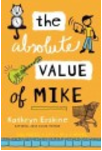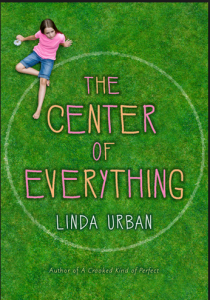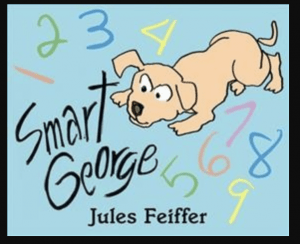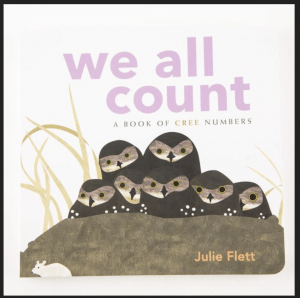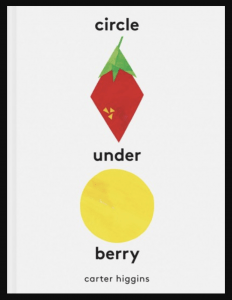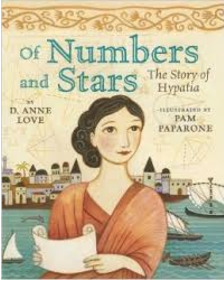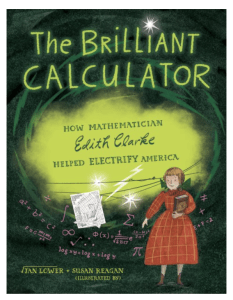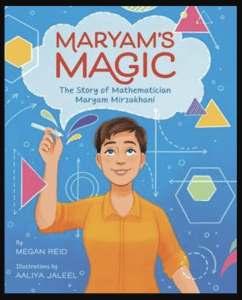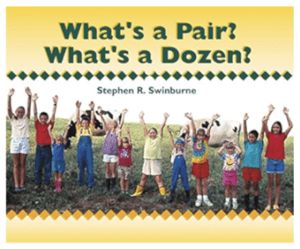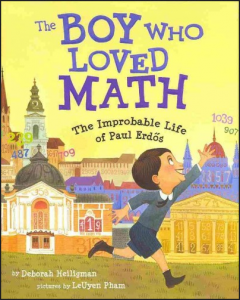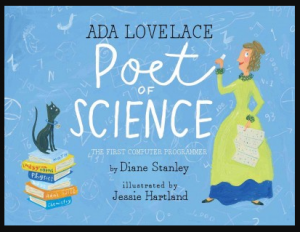Math is Everywhere!
Novels
Erskine, Kathryn. The Absolute Value of Mike. Philomel Books, 2011.
Fourteen-year-old Mike is great at engineering events but terrible at math – much to the dismay of his eccentric mathematician father – and spends the summer helping poeple raising money to adopt a Romanian orphan. [Self-acceptance; Summer; Pennsylvania; Fathers and sons; Adoption; Eccentrics and eccentricity; Individuality; Mathematics; Grief]
Levine, Kristin. The Lions of Little Rock. New York: G. P. Putnam’s Sons, 2012.
Twelve-year-old Marlee is shy. She likes thinking and she likes math, but she doesn’t like talking so much. And she is not courageous. But when high schools are closed in her home town because local officials oppose integration, Marlee learns to speak up. Well-researched and based on true events from 1959, this novel will appeal to readers twelve years old and up. [Arkansas; African Americans; Racism; Schools; Family life; Mothers and daughters; Mathematics; Historical fiction; Friendship; Courage; Faith]
Secrets, Lies, and Algebra by Wendy Lichtman (Greenwillow Books, 2007) is an intriguing novel about lies, secrets and, well, algebra. Tess is going to Westlake Middle where everything is going as usual until she sees her classmate, Richard, secretly copying the US constitution test that he snuck out of the teacher’s office. Will she tell? Will she not? This is not the only secret in the novel. Tess’s mom thinks her friend has murdered his wife. He says she committed suicide, but Tess’s mom thinks differently. Will Tess tell the cops about her mom’s suspicions? Will she tell her friends about the supposed murder? You’ll have to read the novel to find out! I recommend this novel to anyone looking for a mysterious but humorous novel about friendship. (Andriana in grade eight)
Do the Math: Secrets, Lies, and Algebra by Wendy Lichtman (2007, Greenwillow Books) is a unique book about Tess, a thirteen-year-old math wiz who uses math to solve her real life problems: friendship and murder. Math is the one subject Tess can trust – there is always one right answer, and it never changes. Is this true in life? The story is full of math concepts, which allows readers to view their lives in a different way. I really enjoyed this story and recommend it to teen girls who enjoy math. (Natalie in grade eight)
The Writing on the Wall by Wendy Lichtman (Greenwillowbooks, 2008) is an interesting novel about an eighth grader, Tess, who compares her life to math problems. She is just an average girl going to Westlake Middle before she sees equations on a wall behind her school. Tess then faces a dilemma: should she try to figure out the significance of the strange equation or just forget about it? Unfortunately, the temptation to solve the mystery is too much for her. What will happen to Tess? Will this put her life in danger? Will she figure out the mystery? Well, you’ll have to read this intriguing novel about bullying, friends, secrets, boys, and, of course, algebra to find the answers. (Andriana in grade eight)
Roy, Jennifer. Mindblind. Marshall Cavendish, 2010.
Fourteen-year-old Nathaniel thinks that life will be so much better for him if he can only prove that he is a genius. His quest exasperates his mother with whom he lives and irritates his father who is determined to have a “normal” son. It is his friends, finally, who come to his rescue and show him he can have fun with both people and mathematical formulas in his life. [Divorce; Asperger’s syndrome; Rock groups; Genius; Fathers and sons; Stepfamilies; Mathematics; Dating (Social customs)]
Urban, Linda. The Center of Everything. Boston: Harcourt Children’s Books, 2013.
Grieving for her grandmother, twelve-year-old Ruby prepares to read her award-winning essay at the annual parade honouring her town’s founder, the inventor of a doughnut with a hole in the middle. Moving backwards and forwards through time with references to mathematics and ancient cultures and explorers, this novel will be appreciated by readers 11-years-old and up who have enjoyed stories by Ruth White. [New Hampshire]
Picture Books
Brocket, Jane. 1 Cookie, 2 Chairs, 3 Pears. Minneapolis: Millbrook Press, 2014.
Campbell, Sarah C. Growing Patterns: Fibonacci Numbers in Nature. Boyds Mills Press, 2010.
Dodds, Dayle Ann. Full House: An Invitation to Fractions. Candlewick Press, 2007.
An amusing rhyming story, with full-page illustrations reminiscent of Steven Kellogg books, useful for introducing the concept of fractions to young children.
Feiffer, Jules. Smart George. New York: Michael di Capua Books, HarperCollins Publishers, 2020.
Flett, Julie. We All Count: A Book of Cree Numbers. Vancouver, BC: Native Northwest.com, 2018.
Gifford, Scott. Piece = Part = Portion. Tricycle Press, 2003.
Cheery full-page photographs illustrate equivalent fractions, decimals and percentages.
Hall, Michael. Perfect Square. Greenwillow Books, 2011.
A smiling square loses its hard edges as it becomes a window, a mountain, a river, a bridge, a park, a garden and a fountain in this picture book, fun for preschoolers but useful for introducing the concept of theme to older students.
Higgins, Carter. Circle Under Berry. San Francisco: Chronicle Books, 2021.
Love, D. Anne. Of Numbers and Stars. New York: Holiday House, 2006.
Almost 2000 years ago in Egypt, in the famous city of Alexandria, a girl was born who would grow up to be a teacher renowned for her knowledge of science, mathematics and philosophy. People came from all over to learn from her and to seek her advice. Unfortunately, eventually, more powerful people in Alexandria became displeased with her independent thinking. This gently illustrated and informative picture book biography tells Hypatia’s (Hi-PAY-shu’s) story in a style reminiscent of Miss Rumphius by Barbara Cooney and is suitable for readers – and listeners – aged eight to eighty. [Egypt, Ancient; Hypatia; Mathematicians; Philosophers]
Lower, Jan. The Brilliant Calculator: How Mathematician Edith Clarke Helped Electrify America. New York: Calkins Creek, an imprint of Astra Books for Young Readers, 2023.
Edith Clarke was born in 1883 and grew up loving numbers, excelling at school math competitions. She was sent to boarding school to learn about manners and music but instead dreamed of building railroads and bridges. After attending college, she became a math and physics teacher and helped invent a slide rule to speed up math calculations. She studied engineering, designed electrical transmission lines, and invented a calculator to help other engineers provide electricity for people all across America. All this information is told as a smoothly flowing story, in short sentences comfortable for reading silently or aloud. Extensive additional information is included at the end: an author’s note; a timeline; a glossary; a descriptive list of eight more women mathematicians, engineers, and inventors; and a lengthy bibliography. A beautifully designed and illustrated biography highly recommended for readers 9 to 90 years old.
Otoshi, Kathryn. Zero. KO Kids Books, 2010.
This delightful story of zero who was afraid she was worthless but discovered she brings value to all the other digits is a a great read-aloud for any math class and would make a great discussion starter for any class at all.
Reid, Megan. Maryam’s Magic: The Story of Mathematician Maryam Mirzakhani. New York: Balzer + Bray, 2021.
Are you a numbers person? Do you enjoy working with equations? Or are you a word person? Do you like reading and writing? Or do you like both mathematics and stories?
Maryam preferred stories. Until – when she was 12 years old – she discovered geometry. Now she could turn numbers into shapes! And shapes made stories! This inspiring picture book biography tells the story of the first woman and first Iranian to win the prestigious Fields Medal, the mathematical equivalent of the Nobel Prize. Accompanied by additional facts and references at the end, it is recommended for readers 7 to 11 years old.
Rosenthal, Amy Krouse. This Plus That: Life’s Little Equations. HarperCollins Children’s Books, 2011.
A creative little story showing how all sorts of moments bring happiness in life: “1 + 1 = us” and “chores ÷ everyone = family”.
Rumford, James. Nine Animals and the Well. Houghton Mifflin Company, 2003.
The rhythm in this hilarious tale about nine travelling animals bearing gifts for the raja-king makes it a great read-aloud for kindergarten to fourth grade students. And the page at the end that tells how we got the numbers 0 to 9 makes it even more interesting for readers of any age. The digits were invented in India about 1500 years ago and, from there, travelled to Arabia to North Africa and finally to Europe where they were called Arabic numbers.
Schwartz, Joanna. City Numbers. Groundwood Books, 2011.
Photographs by Matt Beam. Useful as a read-aloud for young children or inspiration for an art project for budding photographers.
Swinburne, Stephen R. What’s a Pair? What’s a Dozen? Boyds Mills, 2000.
Tang, Greg. Math Fables Too. Scholastic, 2007.
A counting book about science.
Tang, Greg. Math Potatoes. Scholastic Press, 2005.
Full-page illustrations with math puzzles written as poems.
Nonfiction books
Heiligman, Deborah. The Boy Who Loved Math : the Improbable Life of Paul Erdős. New York: Roaring Brook Press, 2013.
“Growing up in Hungary during WWI, Erdos tried school but chafed at the rules and convinced his mother that he should study at home. He was fascinated by numbers from an early age, and by the time he was 20, he was known as The Magician from Budapest. Unable to do common tasks such as cooking, laundry, or driving, he spent his adult life flying around the world, staying with other mathematicians, and working collaboratively on challenging math problems.” – CIP.

Love, D. Anne. Of Numbers and Stars. New York: Holiday House, 2006.
Almost 2000 years ago in Egypt, in the famous city of Alexandria, a girl was born who would grow up to be a teacher renowned for her knowledge of science, mathematics and philosophy. People came from all over to learn from her and to seek her advice. Unfortunately, eventually, more powerful people in Alexandria became displeased with her independent thinking. This gently illustrated and informative picture book tells Hypatia’s (Hi-PAY-shu’s) story in a style reminiscent of Miss Rumphius by Barbara Cooney and is suitable for readers – and listeners – aged eight to eighty.
Martin, Steve and others. The Wacky & Wonderful World Through Numbers. Hauppauge, NY : Barron’s, 2015, c2013.
A fascinating collection of facts highly recommended for readers 10-years-old and up. A book to buy, so it can be read over and over again.
Rebman, Nick. Adding Apples. Mendota, Minnesota: Little Blue House, 2021. A useful little book about arithmetic with short sentences and full-page illustrations, a table of contents, a glossary, and an index. Only 16 pages long. Superb for teaching parts of a book and the beginning of research skills. Highly recommended for children 5 to 7 years old.
Stanley, Diane. Ada Lovelace: Poet of Science : the First Computer Programmer. New York: Simon & Schuster Books for Young Readers, 2016.
What a brilliant biography! The style of writing is lively and humorous! The illustrations by Jessica Hartland enhance the mood and extend the story. The story is engaging, and additional information – including a bibliography and glossary – is found at the end of the book. Highly recommended for all ages. [Babbage, Charles; Lovelace, Ada King, Countess of; Mathematicians; Women computer programmers].
